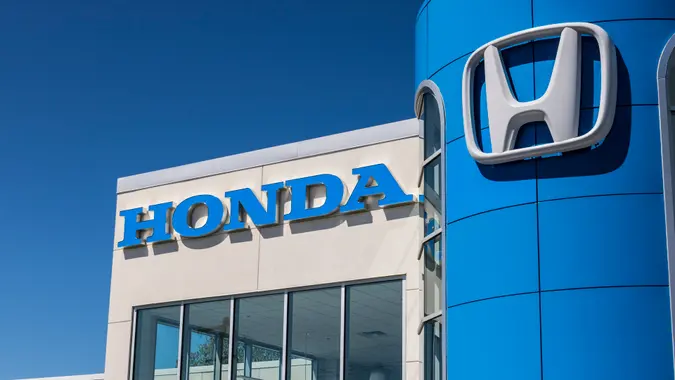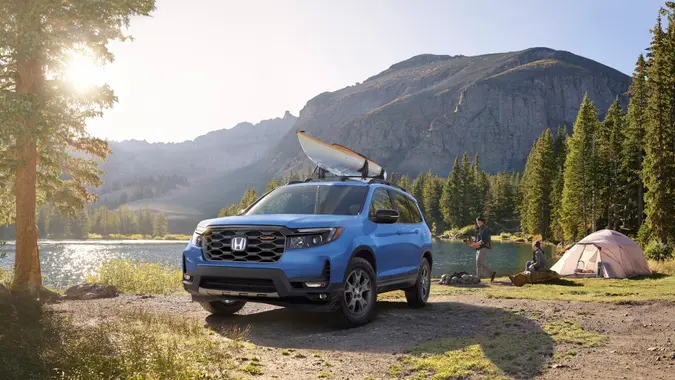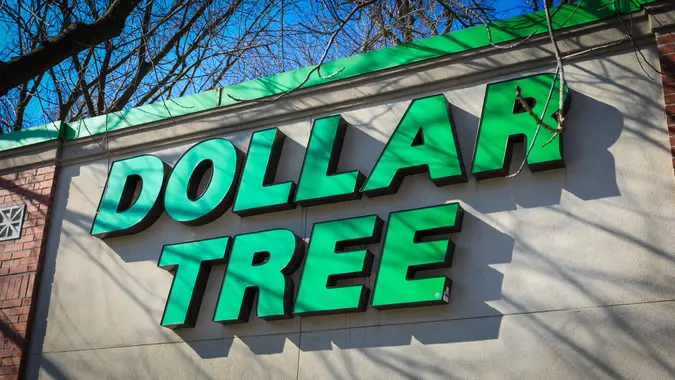Everything You Need To Know When Buying Your First Car

Commitment to Our Readers
GOBankingRates' editorial team is committed to bringing you unbiased reviews and information. We use data-driven methodologies to evaluate financial products and services - our reviews and ratings are not influenced by advertisers. You can read more about our editorial guidelines and our products and services review methodology.

20 Years
Helping You Live Richer

Reviewed
by Experts

Trusted by
Millions of Readers
For many people, their first car might be the largest purchase of their life up to that point. It helps to know what to expect.
This guide covers everything you need to know when buying your first car.
Step 1: Know What You Can Afford
As with any major purchase with ongoing costs, make sure the car of your dreams fits into your budget. Some teens and young adults are fortunate to have their parents buy their first car or at least help with the down payment. Even if you aren’t paying for the vehicle, you’ll need to be sure you can afford the other costs associated with owning a car.
Beyond the Sticker Price
The average price of a new car in April 2025 was $48,699, according to KBB.com. Used car prices averaged $25,547 in April 2025. But the sticker price isn’t the only cost to consider. You’ll have to pay for taxes and registration on the car when you first buy it. Then, there’s going costs of fuel, insurance and maintenance.
If you have a job but haven’t created a budget, now is a good time to do so. You can use a budgeting app to make it easy, or simply make a list of all your income and expenses. That should give you an idea of how much you can afford to spend on fuel, insurance, maintenance and monthly payments on a car loan.
Keep that maximum affordable monthly car payment in mind as you shop for your first car, but don’t share it with the car salesperson when you start negotiating.
Auto Loans and Credit
If you’re financing your new vehicle, your lender will run a credit check. If you have a high credit score of 720 or greater, you’ll qualify for a lower interest rate and better loan terms.
Buy Here, Pay Here
However, if you’re a first-time car buyer with no credit history, you can still find a lender. Often, “buy here, pay here” dealerships offer loans to borrowers with no credit or a low credit score. They will look at your other qualifications, like holding a job with a steady income. Interest rates might be higher on these loans.
Co-Signing
You might be able to get a conventional auto loan if your parents or another trusted adult with a high credit score agrees to co-sign the loan. When you have a co-signer, they agree to take on the responsibility of making the payments if you don’t. Otherwise, if the loan goes into default it can reflect poorly on their credit.
Have a Larger Down Payment
You may be able to find a loan with better terms or lower interest if you put more money down on the vehicle. You might have to delay your purchase while you save up for the down payment.
Tips for Starting a Car Loan Fund
Set a goal and put the cash in a high-yield savings account until you have enough to put down 20% or more on the car you want.
Get Multiple Lender Quotes
Just as you’ll visit multiple dealerships to purchase a car, it pays to shop around to various lenders, too. Compare rates and terms and get pre-approved. Having a loan preapproval shows exactly how much you can afford and puts you in a stronger negotiating position with the auto dealer.
Down Payment Strategy
Having more money down may help you qualify for a loan. It also has other benefits:
- You’re financing less.
- You’ll pay less interest in the long run.
- It helps with securing a lower interest loan.
Since cars depreciate quickly the second they leave the lot, putting more money down helps ensure you won’t be “underwater” on your loan if you want to trade in your car before it’s paid off.
Step 2: Choosing Your Car
The type of car you choose will depend on your driving needs, including your passenger and cargo space requirements, how often and how far you drive and what you’ll use the car for.
Think about these when you’re considering buying a new car:
Safety Features
Without fail, you’ll want to choose a car with the latest safety features, such as:
- A back-up camera
- Lane-assist technology
- Blind spot sensors that alert you when another vehicle is approaching to your side.
Reliability Ratings
You also want to review reliability ratings for the cars you’re considering. As a new driver, you want a car you can trust.
A Car You’re Comfortable With
You also want a car you feel comfortable driving. If you learned how to drive in a small sedan, you might not be comfortable in a large SUV as a new driver.
Tech and Infotainment
Finally, look at the technology and infotainment systems in the vehicle. While this may not be a key selling point for a first car, it’s nice to have modern technology systems you can enjoy.
New vs. Used Vehicles
New Cars
Buying a new car has a number of advantages, including enhanced reliability and the latest features. It’s also good to ensure you have a manufacturer’s warranty to cover costly repairs if something goes wrong within the first three years that you own the car.
New cars typically carry a higher price tag up front, and depreciate in value by 16% within the first year, according to data from KBB.com. Most of that value is lost as soon as the car leaves the lot.
Used Cars
A used car often comes with a lower price tag and won’t depreciate as quickly. However, it may come with unexpected repair costs or reliability issues. Unless you purchase a certified pre-owned vehicle, it may not come with an extended warranty.
There are also safety factors to consider with an older vehicle. A new study rom JAMA Network Open discovered that vehicles six to 15 years old have a 19% greater risk of a fatal crash for the driver. “Given teen drivers’ high crash rates compared to other age groups and their increasing involvement in fatal crashes, it is crucial for teen drivers to operate the safest vehicles available,” Jingzhen Ginger Yang, PhD, MPH, lead author of the study, said.
Step 3: The Car Shopping Process
Once you’ve figured out how much you can afford to spend and the type of vehicle you’d like based on your driving needs, it’s time to start comparing makes and models.
Resources like KBB.com and Edmunds.com offer reliability ratings and car values for new and used vehicles. If you spot a used vehicle you like, you can run a report via Carfax to see if it’s ever been in an accident.
Word-of-mouth is another way to start narrowing down your car search.
Buying Your First Car From a Dealership vs. Private Seller
When you’re buying your first car, you have several shopping options. You can buy a car at a new or used car dealership. Most dealers offer a variety of financing options and typically offer a manufacturer’s extended warranty, even on some used vehicles. However, you might face sales pressure and could pay more for a car at a dealership. Don’t be afraid to walk away if the dealer doesn’t offer what you want or isn’t willing to negotiate.
If you’re shopping for a used car, you can also buy from a private seller. You might pay less, but the car isn’t likely to come with a warranty. You might also have less recourse if you aren’t happy with the vehicle within the first few weeks.
The Test Drive and Pre-Purchase Inspection
Before you finalize a deal, you’ll want to test drive the car. Pay attention to how the car feels and how it handles. Ask yourself the following questions:
- Is the acceleration smooth and zippy?
- Are the controls in intuitive spots?
- Does the onboard technology, including the head-up display, infotainment screen and backup camera meet your expectations?
- Are the seats comfortable?
- Are there enough power ports and cupholders for your needs?
- Is there enough storage space and is it flexible enough to meet your needs?
If you can, drive the car on a variety of road conditions, including a highway and a local street. Try the cruise control and any safety features, such as lane assist.
If you’re buying a used vehicle, it’s a good idea to have an independent mechanic inspect the car, looking for unusual signs of neglect, prospective engine problems that may not be obvious to the untrained eye, and parts, such as tires and brakes, that might need to be replaced soon.
Step 4: Your Purchase: Negotiation and Documents
Once you’ve selected the vehicle you want, it’s time to negotiate. The salesperson is likely going to try to get you to reveal your maximum monthly payment. Don’t answer.
Instead, focus on the total amount you are willing to pay, which includes fees, taxes and any add-ons. The number you share with the dealer should be even lower than what you’re prepared to pay, leaving room for them to make a counter-offer. Negotiate up from your initial offer, not down from the MSRP.
Be willing to get prices from multiple dealers and ask them to beat each other’s prices. Make it clear that you’re willing to walk away if they can’t meet your price. Once you’ve settled on the price for the vehicle, that’s when you begin discussing financing terms.
Financing at the Dealership vs. Other Loan Options
Dealer financing is often easier since you can handle everything in one spot. If you qualify for the dealer’s promotional offers, you might even secure 0% financing. Dealers don’t always offer the lowest rates. It’s best to shop around to third-party lenders. If you have a preapproved loan offer, it can even put you in a better negotiating position to get the car you want.
Securing a loan from a third party lender, like a credit union, takes more time and effort but it can lead to better terms.
What To Bring When Buying Your First Car
When you’re ready to buy your first car, make sure to bring:
- Driver’s license
- Proof of income: pay stubs, W-2, tax returns
- Proof of insurance
- Loan preapproval letter
- Funds for the down payment, registration and other costs
After You Buy a Car: Insurance and Maintenance
Owning a car includes some ongoing costs, including:
Auto Insurance
You’ll need liability insurance, at a bare minimum, if you buy a used car.
If you have an auto loan, your lender may require you to carry comprehensive and collision coverage, which protects their financial interests if your car is damaged in an accident.
Car Maintenance
Make sure to factor in costs for ongoing maintenance, such as regular oil changes and tune-ups. Staying on top of your car’s routine service will help it last longer, keep it safe, and may help it retain its resale value.
Conclusion: Enjoying Your First Car
Congratulations! When you buy your first car, you’ll likely drive away feeling proud and excited. Hopefully, you’ve chosen carefully and your vehicle will give you years of freedom and enjoyment.
Our in-house research team and on-site financial experts work together to create content that’s accurate, impartial, and up to date. We fact-check every single statistic, quote and fact using trusted primary resources to make sure the information we provide is correct. You can learn more about GOBankingRates’ processes and standards in our editorial policy.
- KBB. 2025. "Is Now the Time to Buy, Sell, or Trade in a Car?"
- KBB. "Car Depreciation Calculator."
- Nationwide Children's Hospital. 2025. "Study Finds Teens Driving Older Vehicles Have Increased Risk for Fatal Crashes."
 Written by
Written by  Edited by
Edited by 
























